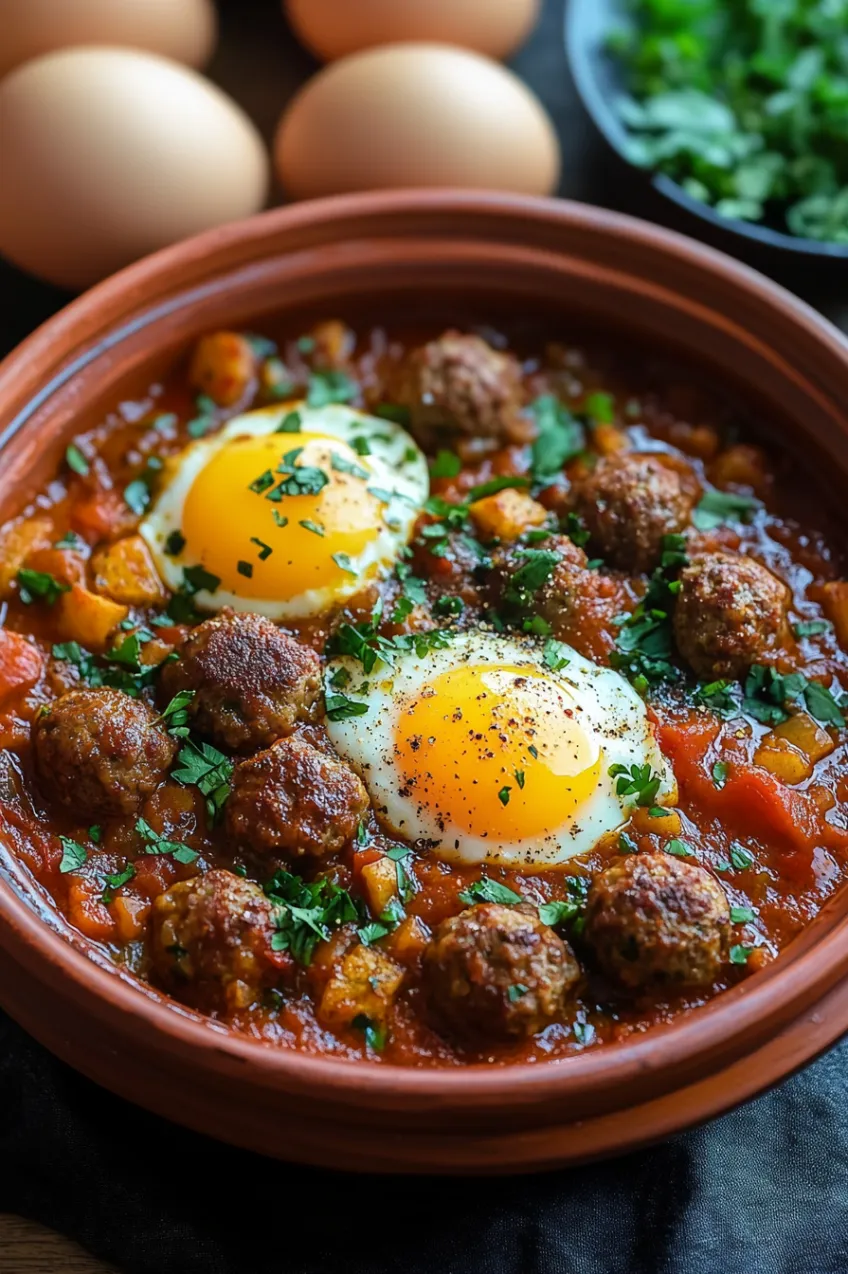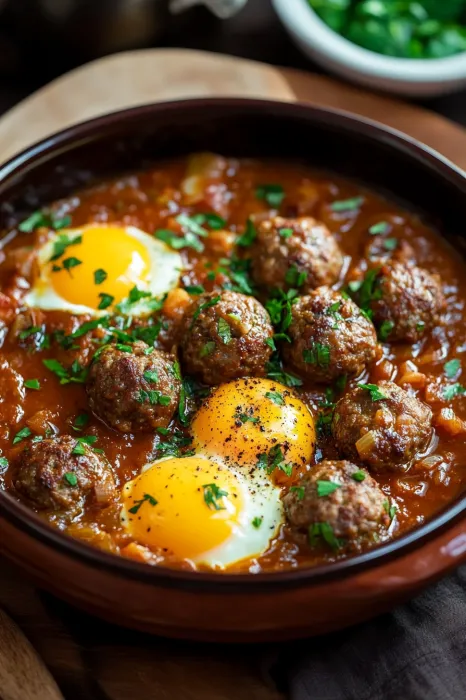 Save
Save
This rustic Kefta Mkaouara has transported my family to Morocco at least once a month since I discovered it five years ago during my culinary exploration of North African cuisine. The combination of tender spiced meatballs swimming in a rich tomato sauce with perfectly set eggs creates a one-pan wonder that consistently impresses both family and dinner guests.
I first made this dish after returning from a trip to Marrakech where I became obsessed with the complex flavors of Moroccan cuisine. This recipe brings those market aromas straight to my kitchen and has become our go-to comfort meal during winter months.
Ingredients
- Ground lamb or beef with 80/20 fat ratio ensures juicy meatballs that won't dry out during cooking
- Fresh parsley adds brightness and traditional Moroccan flavor to the meatballs
- Cumin provides earthy warmth essential to authentic North African cuisine
- Cinnamon adds subtle sweetness that balances the acidity of tomatoes
- Fresh eggs create luxurious pockets of richness throughout the dish
- Tomato paste intensifies the sauce flavor and creates proper thickness
- Olive oil contributes necessary richness and authentic Mediterranean flavor
- Fresh cilantro brightens the finished dish and adds visual appeal
Step-by-Step Instructions
- Prepare the meatball mixture
- Combine ground meat with minced onion, garlic, parsley and all spices in a large bowl. Use your hands to gently incorporate ingredients without overworking the meat. The warmth of your hands helps distribute spices evenly while maintaining tenderness. Mix only until ingredients are just combined to ensure light, tender meatballs.
- Form the meatballs
- With slightly damp hands, portion the meat mixture into approximately 1-inch balls. A slightly smaller than golf ball size works perfectly. Roll each portion gently between your palms just until smooth. Place formed meatballs on a plate, allowing air to circulate around them while you prepare the remaining ingredients.
- Brown the meatballs
- Heat olive oil in your tagine or deep skillet until shimmering but not smoking. Add meatballs in a single layer with space between each one. Work in batches to avoid overcrowding which prevents proper browning. Cook for 2-3 minutes until the bottom develops a golden crust, then carefully turn and brown the opposite side. They should be just seared on the outside but not fully cooked through.
- Create the sauce base
- Using the same pan with all those flavorful browned bits, sauté chopped onions until they become translucent and begin to caramelize at the edges. Add minced garlic and cook just until fragrant, about 60 seconds, being careful not to let it burn. This aromatic foundation creates the essential flavor base for the entire dish.
- Develop the tomato sauce
- Add diced tomatoes with their juice, tomato paste, and remaining spices to the pan. Stir well to incorporate all ingredients and scrape any browned bits from the bottom of the pan. Allow mixture to simmer uncovered for 10 minutes, stirring occasionally until it thickens slightly and the flavors begin to meld together into a rich, aromatic sauce.
- Simmer meatballs in sauce
- Return the browned meatballs to the sauce, nestling them gently into the liquid. Cover the pan and reduce heat to maintain a gentle simmer for 20 minutes. During this time, the meatballs will finish cooking while absorbing the flavors of the sauce and simultaneously enriching it with their own juices.
- Add the eggs
- Use the back of a spoon to create small wells in the sauce between the meatballs. Crack eggs individually into these depressions, spacing them evenly throughout the pan. Cover again and continue cooking for 5-7 minutes until egg whites are fully set but yolks remain slightly runny. The residual heat will continue cooking them after removal from heat.
- Garnish and serve
- Sprinkle the entire dish generously with fresh cilantro leaves just before bringing to the table. Serve directly from the cooking vessel for a rustic presentation, alongside plenty of crusty bread for soaking up the extraordinary sauce.
 Save
Save
This dish takes me back to a small restaurant in Essaouira where I first tasted it, served by an elderly woman who insisted the secret was in allowing the meatballs to simmer slowly in the sauce. The patience required is minimal compared to the extraordinary flavor reward.
Making Ahead and Storage
This tagine actually improves in flavor after a day in the refrigerator. Prepare through the meatball simmering stage, then cool completely before refrigerating for up to three days. When ready to serve, reheat gently on the stovetop until bubbling, then add fresh eggs and finish as directed in the recipe. The flavors will have deepened beautifully during the rest period.
Perfect Pairings
While traditionally eaten with Moroccan khobz bread, this versatile dish pairs wonderfully with any crusty bread capable of soaking up the sauce. For a complete meal, serve alongside a simple salad of cucumber, tomato and red onion dressed with lemon juice and olive oil. The bright acidity provides perfect contrast to the rich tagine.
Regional Variations
This particular version hails from central Morocco, specifically the Marrakech region. Other areas might include olives, preserved lemon, or even a touch of harissa for heat. In some mountain villages, they include seasonal vegetables like bell peppers or zucchini alongside the meatballs. Each family typically has their own closely guarded recipe, passed down through generations.
Recipe FAQs
- → Can I make Kefta Mkaouara without a tagine?
Yes, absolutely! While a tagine gives the dish authenticity, a large deep skillet or Dutch oven with a lid works perfectly well. The important thing is to have a wide cooking surface for the eggs and a lid that traps moisture during cooking.
- → What meat works best for this dish?
Traditional Kefta Mkaouara uses lamb, but beef works excellently too. The key is choosing ground meat with about 20% fat content (80/20 ratio) to ensure juicy, flavorful meatballs. You can also use a combination of lamb and beef for more complex flavor.
- → How do I know when the eggs are properly cooked?
The eggs should be cooked until the whites are completely set but the yolks remain somewhat runny. This usually takes 5-7 minutes after adding them to the hot sauce. Watch closely as they cook - you want that perfect balance where the whites are firm but the yolks remain soft enough to blend with the sauce.
- → What's the best way to serve Kefta Mkaouara?
Serve Kefta Mkaouara directly from the cooking vessel while still hot. Traditionally, this dish is enjoyed with Moroccan bread (khobz), but any crusty bread works well for sopping up the flavorful sauce. You can also serve it with couscous or rice as an alternative base.
- → Can I prepare components of this dish ahead of time?
Yes! You can prepare the meatballs and even brown them a day ahead, storing them covered in the refrigerator. The tomato sauce base can also be made in advance. When ready to serve, reheat the sauce, add the meatballs to finish cooking, then add fresh eggs for the final stage.
- → What spices can I substitute if I'm missing some ingredients?
While cumin and paprika are essential for authentic flavor, you can substitute ground coriander with more cumin or a touch of ground cardamom. If cinnamon isn't available, allspice makes a reasonable substitute. For depth, you can also add a pinch of cayenne pepper or harissa paste if you enjoy heat.
